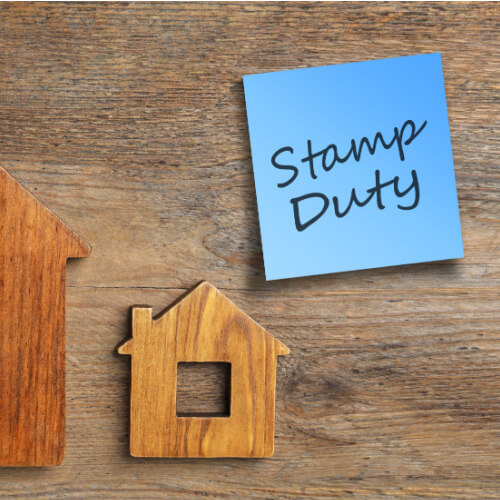 Written by James Hurwood
Written by James Hurwood
Reviewed by Stephen Zeller
Last updated 09/01/2024
Don't quite understand stamp duty? You might want to watch this explainer from Selling Houses Australia host, Andrew Winter.
![]()
Stamp duty can cost you tens of thousands of dollars, so it pays to be prepared. With that in mind, our General Manager of Money, Stephen Zeller has some stamp duty-related tips for Tasmanians:
Stamp duty charges differ depending on where you’re purchasing a property in Australia. When working out the estimated stamp duty for a home you’re looking to purchase, make sure you’ve selected the correct state/territory as you could potentially underestimate or overestimate the charges applicable.
Stamp duty is often forgotten about when looking at homes for sale and calculating the final costs. When completing your sums for purchasing a home, don’t forget to include the stamp duty premium as well, as you may be in for a shock if you find out you might not have enough funds to complete the purchase.
Our Home Loan Specialist team are here to help with any of your stamp duty queries and any other home loan questions on your mind. You can speak to the team via phone or email and they’ll be happy to assist you.
When purchasing a property, there are a host of additional costs that are important to keep in mind – and stamp duty is perhaps the heftiest of them all. In Tasmania, stamp duty is charged on a sliding scale based on either the property’s market value, or the consideration (that is, the agreed purchase price of the property) – whichever figure is greater.¹
Tasmania’s payable stamp duty rates as of August 2022 are:
| Property value | Stamp duty payable |
| $3,000 or less | $50 |
| $3,000-$24,999 | $50, plus $1.75 for every $100 or part of $100 over $3,000 |
| $25,000-$74,999 | $435, plus $2.25 for every $100 or part of $100 over $25,000 |
| $75,000-$199,999 | $1,560, plus $3.50 for every $100 or part of $100 over $75,000 |
| $200,000-$374,999 | $5,935, plus $4.00 for every $100 or part of $100 over $200,000 |
| $375,000-$724,999 | $12,935, plus $4.25 for every $100 or part of $100 over $375,000 |
| More than $725,000 | $27,810, plus $4.50 for every $100 or part of $100 over $725,000 |
For example, imagine Sam buys a house in Tasmania for $500,000. Assuming Sam isn’t eligible for any stamp duty concessions or exemptions, they’re on the hook for $12,935 of stamp duty plus $4.25 for every $100 or part of $100 making up the difference between $375,000 and $500,000.
This difference is $125,000 which, when divided by $100, gives us 1,250. Multiply this by $4.25 and we get $5,312.50, and when added to $12,935, gives us a final amount of $18,247.50.
Keep in mind that this is a very basic estimation of the stamp duty Sam might have to pay on their property purchase. There are many different factors that can affect your payable stamp duty beyond the value of the property, so you may want to seek professional advice if you’re looking for a more accurate estimate. Furthermore, the Tasmania state government offers several concessions and exemptions which, depending on your circumstances, may affect the amount of stamp duty you have to pay on your eligible property purchase.
Stamp duty is payable in Tasmania on the purchase and title transfer of:¹
In Tasmania, you must pay stamp duty within three months of the property’s transferral into your name. However, most homebuyers will generally engage the services of a conveyancer or solicitor to assist them during the homebuying process, and they’ll typically handle the paying of your stamp duty for you.
You may want to check with your nominated conveyancer or solicitor for clarity on how this will work, and what the timeline looks like for the payment of your stamp duty.
In Tasmania, you can pay your stamp duty via mail or electronically at Tasmania Revenue Online.¹
However, most homebuyers tend to work with a solicitor or conveyancer during the homebuying process, and so they’ll typically handle the stamp duty payment process on your behalf.

First home buyers in Tasmania who purchase an established home worth $600,000 or less for the purpose of using it as their principal place of residence prior to 30 June 2024 are eligible for a 50% concession on their payable stamp duty.³
Tasmania offers a number of stamp duty concessions and exemptions to eligible individuals, including:4
However, it’s worth keeping in mind that each of these concessions and exemptions come with their own sets of stipulations and eligibility requirements. Be sure to thoroughly assess your own eligibility for any concessions or exemptions you’re considering applying for before doing so.
As mentioned above, there’s a 50% stamp duty concession available to eligible pensioners downsizing to a smaller, less valuable property.5 In order to be eligible for this concession, the following conditions must be met:
Tasmania charges a Foreign Investor Duty Surcharger (FIDS) when residential or primary production property is acquired, directly or indirectly, by a foreign person.6
As of April 2020, the FIDS is charged at a rate of:
Foreign buyers may be exempt from paying the FIDS if the property in question is an existing dwelling being purchased by parties to a marriage or significant relationship in equal shares, who plan on using it as their principal place of residence within six months of the purchase and only one of the parties is a foreign natural person.
An exemption also exists for foreign buyers purchasing vacant land with the intention of building a principal place of residence on it. However, if you’re a foreign buyer considering buying property in Tasmania, you should investigate your own potential eligibility for a duty exemption before making any decisions.
![]()
Stephen has more than 30 years of experience in the financial services industry and holds a Certificate IV in Finance and Mortgage Broking. He’s also a member of both the Australian and New Zealand Institute of Insurance and Finance (ANZIIF) and the Mortgage and Finance Association of Australia (MFAA).
Stephen leads our team of Home Loan Specialists, and reviews and contributes to Compare the Market’s banking-relating content to ensure it’s as helpful and empowering as possible for our readers.
1 State Revenue Office of Tasmania. Property Transfer Duties – Land. 2022.
2 State Revenue Office of Tasmania. Rates of duty. 2022.
3 State Revenue Office of Tasmania. First home buyers of established homes duty concession. 2022.
4 State Revenue Office of Tasmania. Concessions and exemptions. 2022.
5 State Revenue Office of Tasmania. Pensioners downsizing to a new home duty concession. 2022.
6 State Revenue Office of Tasmania. Foreign investor duty surcharge. 2022.